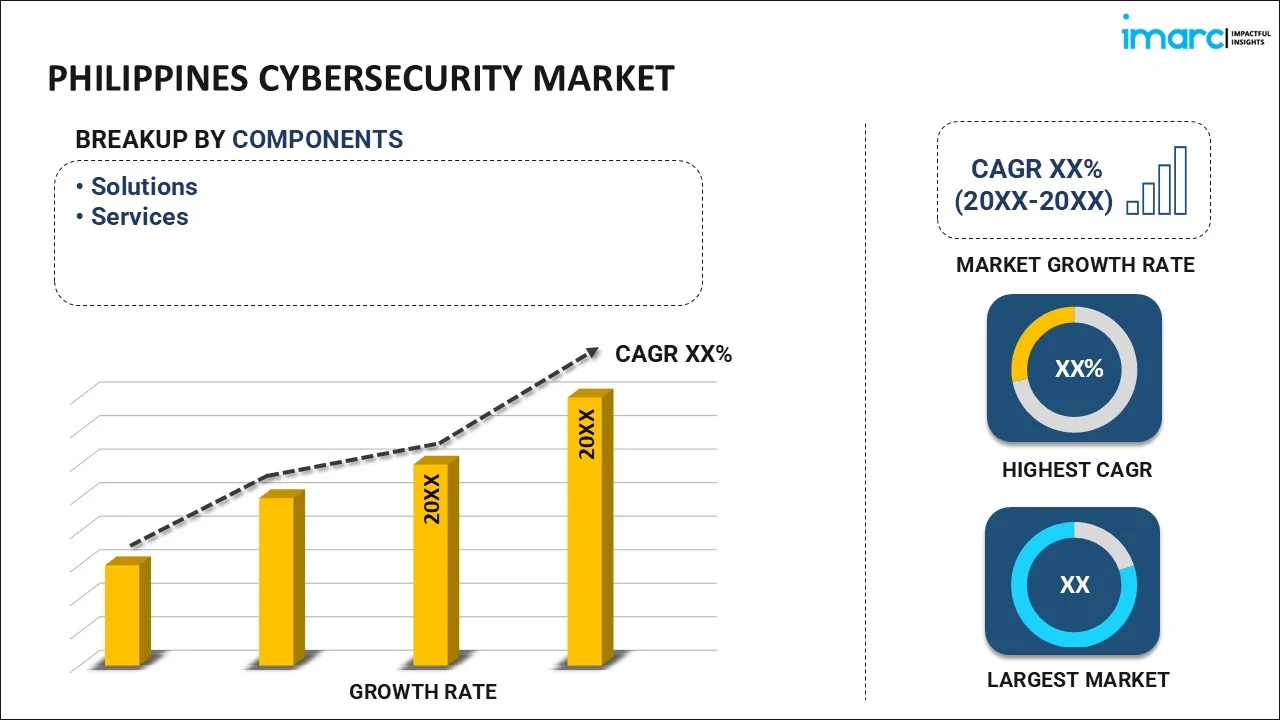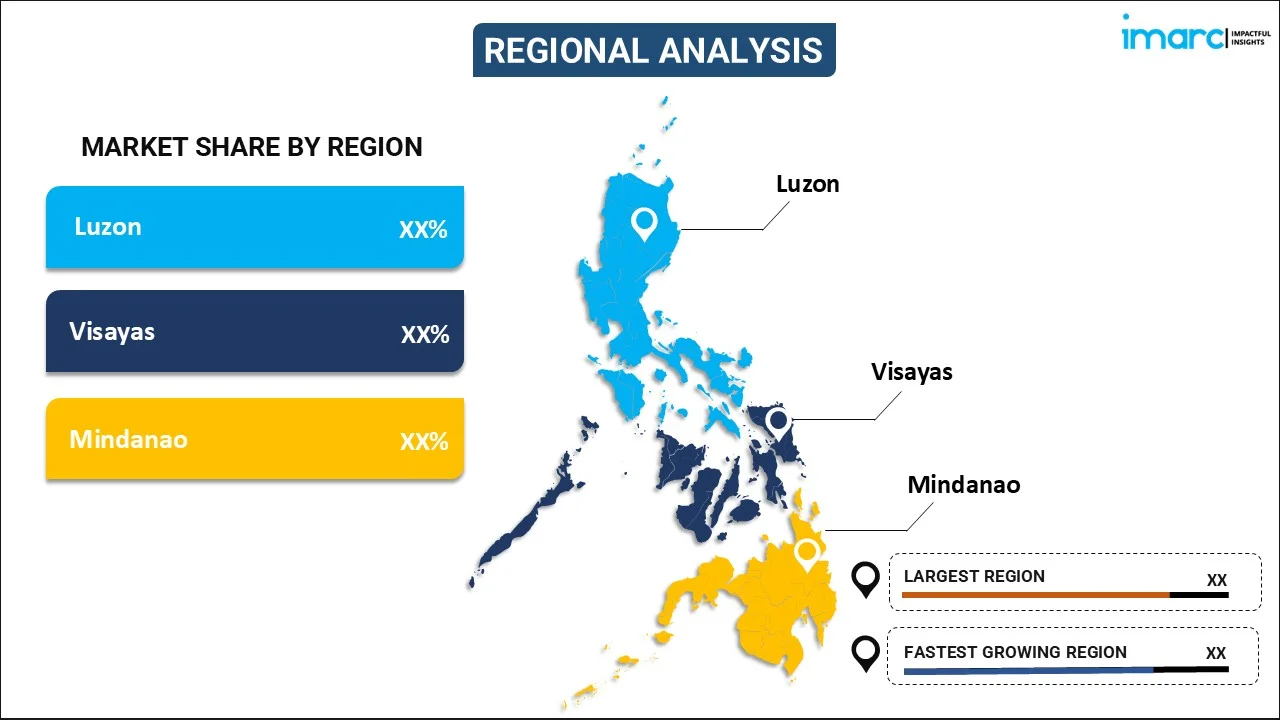
Philippines Cybersecurity Market Size, Share, Trends and Forecast by Component, Deployment Type, User Type, Industry Vertical, and Region, 2025-2033
Philippines Cybersecurity Market Overview:
The Philippines cybersecurity market size reached USD 1.30 Billion in 2024. Looking forward, IMARC Group expects the market to reach USD 2.72 Billion by 2033, exhibiting a growth rate (CAGR) of 8.50% during 2025-2033. Along with the growing cooperation between regional government agencies and international cybersecurity organizations, which brings in expertise and tools to improve the country's cybersecurity capacities, the Philippines' cybersecurity market share is growing due to the growing adoption of cloud computing, the Internet of Things (IoT), and artificial intelligence (AI), which is creating more access points for cybercriminals.
|
Report Attribute
|
Key Statistics
|
|---|---|
|
Base Year
|
2024 |
|
Forecast Years
|
2025-2033
|
|
Historical Years
|
2019-2024
|
| Market Size in 2024 | USD 1.30 Billion |
| Market Forecast in 2033 | USD 2.72 Billion |
| Market Growth Rate (2025-2033) | 8.50% |
Philippines Cybersecurity Market Trends:
Rapid Digital Transformation
The swift digital transformation is driving the expansion of the cybersecurity market in the Philippines. With the shift of many businesses and services to the internet, including e-commerce, digital transactions, remote employment, and online learning, the demand for robust cybersecurity protocols is significant. Businesses are embracing cloud computing, AI, and the IoT, leading to increased entry points for cybercriminals. This increases the importance of protecting sensitive data, financial transactions, and customer information. As Filipinos more frequently depend on digital platforms for daily activities, the need for strong cybersecurity measures, including firewalls, encryption, and threat detection systems, is growing. Companies, particularly in industries such as banking and healthcare, are increasing their investments in cybersecurity to avert data breaches, fraud, and hacking. Furthermore, due to government policies and regulations promoting digital security, businesses are becoming increasingly proactive in safeguarding their digital assets. According to details on the official site of the Republic of the Philippines, the suggested budget for 2024 set aside P38.75 Billion for digitalization efforts, marking a 60.6% rise from the P24.93 Billion in 2023, aimed at improving public services. With the rapid pace of digital transformation, an increasing number of organizations are recognizing the significance of protecting their networks from evolving cyber threats.
Growing Implementation of Government Initiatives
The increasing implementation of government initiatives is offering a favorable Philippines cybersecurity market outlook. With the high number of cyber threats, government agencies are making cybersecurity a priority by setting up policies and frameworks to protect critical infrastructure, businesses, and individuals. Government programs aim to improve the country’s defense against cyberattacks and build a stronger digital infrastructure. The government is also working on establishing regulations that require companies to adopt cybersecurity measures and report breaches, which motivates businesses to spend resources on better security solutions. In December 2025, The Cybercrime Investigation and Coordinating Center (CICC), Philippines introduced ‘Protecta Fintech’, a project focused on establishing a more secure fintech environment in the Philippines. The event at the National Cybercrime Hub in Bonifacio Global City, Taguig on Dec. 6 gathered leaders from both public and private sectors to address increasing cybercrime threats, especially during the busy holiday season for online transactions. Apart from this, by partnering with international cybersecurity organizations, the government brings in expertise and resources to strengthen the country's cybersecurity capabilities. Moreover, the government supports training programs to increase the number of skilled cybersecurity professionals in the country. It also allocates budgets to fund national cybersecurity efforts and encourages local businesses to follow best practices. These initiatives create a safer digital environment, attracting more investments.
Philippines Cybersecurity Market Segmentation:
IMARC Group provides an analysis of the key trends in each segment of the market, along with forecasts at the regional level for 2025-2033. Our report has categorized the market based on component, deployment type, user type, and industry vertical.
Component Insights:

- Solutions
- Identity and Access Management (IAM)
- Infrastructure Security
- Governance, Risk and Compliance
- Unified Vulnerability Management Service Offering
- Data Security and Privacy Service Offering
- Others
- Services
- Professional Services
- Managed Services
The report has provided a detailed breakup and analysis of the market based on the components. This includes solutions (identity and access management (IAM), infrastructure security, governance, risk and compliance, unified vulnerability management service offering, data security and privacy service offering, and others) and services professional services and managed services).
Deployment Type Insights:
- Cloud-based
- On-premises
A detailed breakup and analysis of the market based on the deployment types have also been provided in the report. This includes cloud-based and on-premises.
User Type Insights:
- Large Enterprises
- Small and Medium Enterprises
The report has provided a detailed breakup and analysis of the market based on the user types. This includes large enterprises and small and medium enterprises.
Industry Vertical Insights:
- IT and Telecom
- Retail
- BFSI
- Healthcare
- Defense/Government
- Manufacturing
- Energy
- Others
A detailed breakup and analysis of the market based on the industry verticals have also been provided in the report. This includes IT and telecom, retail, BFSI, healthcare, defense/government, manufacturing, energy, and others.
Regional Insights:

- Luzon
- Visayas
- Mindanao
The report has also provided a comprehensive analysis of all the major regional markets, which include Luzon, Visayas, and Mindanao.
Competitive Landscape:
The market research report has also provided a comprehensive analysis of the competitive landscape. Competitive analysis such as market structure, key player positioning, top winning strategies, competitive dashboard, and company evaluation quadrant has been covered in the report. Also, detailed profiles of all major companies have been provided.
Philippines Cybersecurity Market News:
- In September 2024, Tata Consultancy Services (TCS), a well-known multinational technical company based in India, introduced its TCS Pace Studio in Manila, Philippines, to expedite digital innovations for clients throughout the Asia Pacific area. This cutting-edge facility, situated in TCS’ Panorama Tower office, was intended to create custom solutions utilizing new technologies, such as AI and cybersecurity.
- In May 2024, Discovermarket, a specialist in insurtech, proclaimed its launch in the Philippines. This action featured a collaboration with Globe, the country's top telecommunications company, to release an integrated CyberInsurance offering. This collaboration sought to offer Globe's clients enhanced security against these dangers. The updated cyber retail offering encompassed online identity theft, shopping scams, and internet payment transactions, providing support services for claims up to PHP ₱100,000.
Philippines Cybersecurity Market Report Coverage:
| Report Features | Details |
|---|---|
| Base Year of the Analysis | 2024 |
| Historical Period | 2019-2024 |
| Forecast Period | 2025-2033 |
| Units | Billion USD |
| Scope of the Report |
Exploration of Historical Trends and Market Outlook, Industry Catalysts and Challenges, Segment-Wise Historical and Future Market Assessment:
|
| Components Covered |
|
| Deployment Types Covered | Cloud-based, On-premises |
| User Types Covered | Large Enterprises, Small and Medium Enterprises |
| Industry Verticals Covered | IT and Telecom, Retail, BFSI, Healthcare, Defense/Government, Manufacturing, Energy, Others |
| Regions Covered | Luzon, Visayas, Mindanao |
| Customization Scope | 10% Free Customization |
| Post-Sale Analyst Support | 10-12 Weeks |
| Delivery Format | PDF and Excel through Email (We can also provide the editable version of the report in PPT/Word format on special request) |
Key Questions Answered in This Report:
- How has the Philippines cybersecurity market performed so far and how will it perform in the coming years?
- What is the breakup of the Philippines cybersecurity market on the basis of component?
- What is the breakup of the Philippines cybersecurity market on the basis of deployment type?
- What is the breakup of the Philippines cybersecurity market on the basis of user type?
- What is the breakup of the Philippines cybersecurity market on the basis of industry vertical?
- What are the various stages in the value chain of the Philippines cybersecurity market?
- What are the key driving factors and challenges in the Philippines cybersecurity market?
- What is the structure of the Philippines cybersecurity market and who are the key players?
- What is the degree of competition in the Philippines cybersecurity market?
Key Benefits for Stakeholders:
- IMARC’s industry report offers a comprehensive quantitative analysis of various market segments, historical and current market trends, market forecasts, and dynamics of the Philippines cybersecurity market from 2019-2033.
- The research report provides the latest information on the market drivers, challenges, and opportunities in the Philippines cybersecurity market.
- Porter's five forces analysis assist stakeholders in assessing the impact of new entrants, competitive rivalry, supplier power, buyer power, and the threat of substitution. It helps stakeholders to analyze the level of competition within the Philippines cybersecurity industry and its attractiveness.
- Competitive landscape allows stakeholders to understand their competitive environment and provides an insight into the current positions of key players in the market.
Need more help?
- Speak to our experienced analysts for insights on the current market scenarios.
- Include additional segments and countries to customize the report as per your requirement.
- Gain an unparalleled competitive advantage in your domain by understanding how to utilize the report and positively impacting your operations and revenue.
- For further assistance, please connect with our analysts.
 Inquire Before Buying
Inquire Before Buying
 Speak to an Analyst
Speak to an Analyst
 Request Brochure
Request Brochure
 Request Customization
Request Customization




.webp)




.webp)












